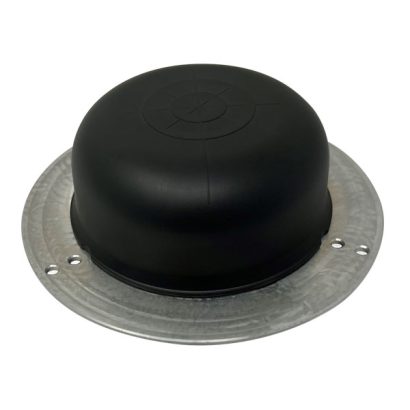
SSL990XF Extended-Filter Housed Full-Band GNSS Low-Profile Antenna
Antennas
Coverage
GPS/QZSS-L1, GPS/QZSS-L2, GPS/QZSS-L5, QZSS-L6, GLONASS-G1, GLONASS-G2, GLONASS-G3, Galileo-E1, Galileo-E5b, Galileo-E6, BeiDou-B1, BeiDou-B2, BeiDou-B2a, BeiDou-B3, NavIC-L5, L-band correction services
Mount
Surface Mount
Amplifier Gain
28 dB typ.
35 dB typ.
Connector Options
SMA (female)
Overview
The patent-pending SSL990XF low-profile cross dipole antenna with parasitic resonators is designed for precision positioning, covering the GPS/QZSS-L1/L2/L5, QZSS-L6, GLONASS-G1/G2/G3, Galileo-E1/E5a/E5b/E6, BeiDou-B1/B2/B2a/B3, and NavIC-L5 frequency bands, including the satellite-based augmentation system (SBAS) available in the region of operation [WAAS (North America), EGNOS (Europe), MSAS (Japan), or GAGAN (India)], as well as L-band correction services.
The SSL990XF utilizes Calian’s latest wideband antenna element design. The antenna element provides 67 MHz of signal bandwidth supporting the entire upper GNSS band and L-Band corrections (1539 – 1606 MHz) and 136 MHz of the lower band signal bandwidth (1164 – 1300 MHz). The other key component of the antenna is the axial ratio, which is a measure of how well the antenna captures the broadcast Right Hand Circular Polarized (RHCP) signal and mitigates the reflected LHCP signals.
The Calian SSL990XF has a high peak gain of 2.5 dBi and ≤ 1.5 dB (typical) axial ratio at zenith, enabling excellent multipath mitigation and a very precise phase centre. The SSL990XF features Tallysmans eXtended Filter (XF) and industry-leading low current, low-noise amplifier (LNA) that includes an integrated low-loss pre-filter to prevent harmonic interference from high-amplitude signals, such as 700 MHz band LTE and other near-band cellular signals. As the radio frequency spectrum has become more congested, the signals or harmonic frequencies of new LTE bands [e.g. 800MHz x 2 = 1600MHz (GLONASSG1)] can affect GNSS antennas and receivers. In North America, planned Ligado signals at 1525 – 1536 MHz can especially impact GNSS antennas that support space-based L-band correction services (1539 – 1559 MHz). New LTE signals in Europe [Band 32 (1452 – 1496 MHz)] and Japan [Bands 11 and 21 (1476 – 1511 MHz)] have also been observed to interfere with GNSS signals. In addition, Inmarsat satellite communication (uplink: 1626.5 – 1660.5 MHz) can also affect GNSS signals. The new Calian XF antennas have been designed to mitigate out-of-band signals and prevent GNSS antenna saturation. Calian’s custom XF filtering mitigates all existing signals and new Ligado and LTE signals, enabling the antennas and attached GNSS receivers to perform optimally.
Weighing only 88g, the light and compact SSL990XF features a precision-tuned cross dipole element that provides an excellent axial ratio. The SSL990XF is housed in a weatherproof (IP67) enclosure and is mounted using either adhesive tape or a mounting collar that includes a water proofing O-ring. Two antenna cable connector options are available the first is a female SMA and the second is an MCX. It is an ideal antenna for precision UAV and all applications where lightweight and precision matter.
Features
- Very low noise preamp (2.5 dB typ.)
- Axial ratio (≤ 1.5 dB at zenith)
- High LNA gain (28 dB typ. | 35 dB typ.)
- Low current (25 mA typ. | 31 mA typ.)
- ESD circuit protection (15 kV)
- Invariant performance from 2.2 to 16 VDC
- REACH and RoHS compliant
Benefits
- Extremely light (88g)
- Excellent RH circular polarized signal reception
- Great multipath rejection
- Increased system accuracy
- Excellent signal-to-noise ratio
- Industrial temperature range
